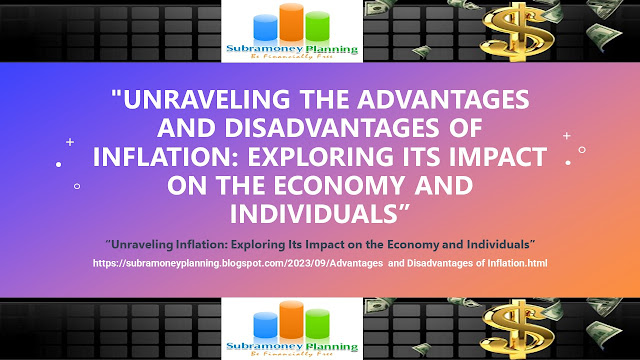Inflation is an economic phenomenon that affects individuals, businesses, and governments worldwide. It has both advantages and disadvantages, influencing various aspects of the economy. In this blog post, we will delve into the advantages of inflation, such as increased profits for businesses, economic growth stimulation, relative price adjustments, and more. We will also explore the disadvantages, including reduced purchasing power, increased uncertainty, income redistribution issues, and others. By understanding these impacts, we can gain a deeper insight into the complexities of inflation and its consequences.
 |
Advantages of Inflation:
1. Increased Profits for Businesses: Inflation can lead to increased profits for businesses that can raise prices faster than their production costs rise. For example, let's consider a company that produces and sells electronic devices. If the cost of production, including raw materials and labor, increases by 3% due to inflation, but the company is able to raise the prices of its products by 5%, it would result in higher profit margins.
Impact: Higher profits allow businesses to reinvest in their operations, expand, and create job opportunities, contributing to economic growth and development.
2. Stimulates Economic Growth: Mild inflation can stimulate economic growth by encouraging spending and investment. When individuals expect prices to rise, they may be more inclined to make purchases or invest their money in productive assets. For example, if consumers anticipate a 2% inflation rate, they may choose to make purchases sooner rather than later to avoid paying higher prices in the future.
Impact: Increased spending and investment can boost aggregate demand, drive production and consumption, and foster economic growth.
3. Adjustments in Relative Prices: Inflation can facilitate adjustments in relative prices, allowing markets to respond to changing supply and demand conditions. As prices rise, consumers may shift their purchasing decisions towards relatively cheaper goods. For instance, during an inflationary period, consumers may choose to purchase substitute goods that offer better value for money.
Impact: This market-driven redistribution of resources helps align supply and demand, improving allocative efficiency and supporting a well-functioning market economy.
4. Encourages Borrowing and Investment: Inflation reduces the real cost of borrowing, as the future repayment of loans is made with inflated currency. This can incentivize businesses and individuals to borrow for investment purposes. For instance, if the inflation rate is 4% and the interest rate on a loan is 3%, the borrower effectively pays back the loan with cheaper money in real terms.
Impact: Increased borrowing and investment can lead to capital formation, innovation, and productivity improvements, driving economic growth.
5. Supports Government Debt Management: Inflation can benefit governments with high levels of debt. If a government issues bonds with fixed interest rates, inflation erodes the real value of the debt over time. For example, if the inflation rate is 5% and a government bond has a fixed interest rate of 2%, the effective interest rate in real terms becomes 3%.
Impact: This reduced burden of interest payments makes it easier for the government to manage its debt obligations, potentially improving fiscal stability.
6. Eases Wage Adjustments: Inflation can facilitate wage adjustments in situations where nominal wage cuts may not be feasible or socially acceptable. Instead of reducing nominal wages, employers may choose to keep wages constant while allowing inflation to erode the real value of wages gradually.
Impact: This approach helps maintain stable labor relations and minimizes the negative impact on workers' morale and well-being during periods of economic downturns.
7. Boosts Asset Values: Inflation can lead to an increase in the value of assets such as real estate, stocks, and commodities. As the general price level rises, the market value of these assets tends to appreciate.
Impact: Asset appreciation can increase household wealth and investment returns, providing individuals and investors with additional financial resources and potentially stimulating consumer spending and investment.
8. Promotes Price Stability: Paradoxically, a moderate level of inflation can contribute to price stability by avoiding deflationary pressures. When prices remain stable or experience mild inflation, it signals a healthy level of economic activity and allows for price adjustments in response to changing market conditions.
Impact: Price stability promotes business confidence, enables effective price signaling in markets, and reduces the risk of prolonged economic downturns.
9. Facilitates Adjustments in Relative Wages: Inflation can help facilitate adjustments in relative wages across different industries and occupations. As prices rise, businesses may face upward pressure to increase wages in sectors where labor is in high demand, ensuring a more balanced distribution of income.
Impact: This can lead to reduced wage inequality, improved labor market efficiency, and enhanced social cohesion.
10. Provides Central Bank Policy Flexibility: Inflation allows central banks to utilize monetary policy tools to manage the economy. By targeting specific inflation rates, central banks can adjust interest rates and money supply to influence borrowing costs, aggregate demand, and employment levels.
Impact: This policy flexibility enables central banks to respond to economic conditions, stabilize financial markets, and promote macroeconomic stability.
Disadvantages of Inflation:
1. Reduced Purchasing Power: Inflation erodes the purchasing power of individuals' income and savings. As prices rise, the same amount of money can buy fewer goods and services.
Impact: Reduced purchasing power can lead to a decline in living standards, particularly for individuals and households with fixed or low incomes.
2. Increased Uncertainty: High or volatile inflation rates can create uncertainty in the economy, making it difficult for businesses and individuals to plan and make informed decisions.
Impact: Uncertainty can hinder long-term investment, disrupt financial markets, and lead to economic instability, affecting business growth and employment opportunities.
3. Income Redistribution Issues: Inflation can impact different income groups unevenly, potentially exacerbating income inequality. Those with fixed incomes or low-wage workers may struggle to keep up with rising prices.
Impact: Income inequality can widen, leading to social tensions and reduced social mobility.
4. Reduced Consumer and Business Confidence: High inflation can erode consumer and business confidence. Consumers may become hesitant to spend and delay major purchases, while businesses may delay investments or hiring decisions due to uncertain market conditions.
Impact: Reduced confidence can lead to decreased consumer spending, lower business investments, and slower economic growth.
5. Negative Effects on Fixed-Income Investments: Inflation can negatively impact fixed-income investments such as bonds and savings accounts. When inflation outpaces the interest earned on these investments, the real value of the returns diminishes.
Impact: Investors relying on fixed-income investments may experience a decline in purchasing power and reduced returns, affecting their financial security and retirement planning.
6. Increased Production Costs: Inflation can lead to higher production costs for businesses, including wages, raw materials, and energy prices.
Impact: Higher production costs can squeeze profit margins, potentially leading to reduced output, layoffs, or increased prices for consumers.
7. Adverse Effects on Export Competitiveness: While moderate inflation can enhance export competitiveness, high inflation can erode a country's competitiveness in the global market.
Impact: If domestic prices rise faster than those in trading partners, it can make exported goods relatively more expensive, potentially leading to a decline in export demand and a negative impact on trade balances.
8. Distorted Economic Signals: Inflation can distort economic signals and hinder efficient resource allocation. Rapidly changing prices can make it challenging for businesses to accurately assess supply and demand conditions.
Impact: This can lead to misallocation of resources, inefficient production decisions, and reduced overall productivity.
9. Potential Wage-Price Spiral: Inflation can contribute to a wage-price spiral, where rising prices lead to demands for higher wages, which, in turn, lead to further price increases.
Impact: This cycle can result in a vicious circle of inflationary pressures, reducing the purchasing power of wages and exacerbating inflationary trends.
10. Increased Cost of Borrowing: High inflation rates can result in higher interest rates, making borrowing more expensive for businesses and individuals.
Impact: Increased borrowing costs can discourage investment and consumption, potentially dampening economic growth.
Inflation has both advantages and disadvantages, impacting various aspects of the economy and individuals' lives. While inflation can increase profits, stimulate economic growth, and support government debt management, it also reduces purchasing power, creates uncertainty, and exacerbates income inequality. Understanding these impacts allows policymakers, businesses, and individuals to make informed decisions and implement measures to mitigate the negative consequences while harnessing the potential benefits of inflation.





%20Answering%20the%20Six%20WH%20Questions%20of%20Portfolio%20Management.jpg)
